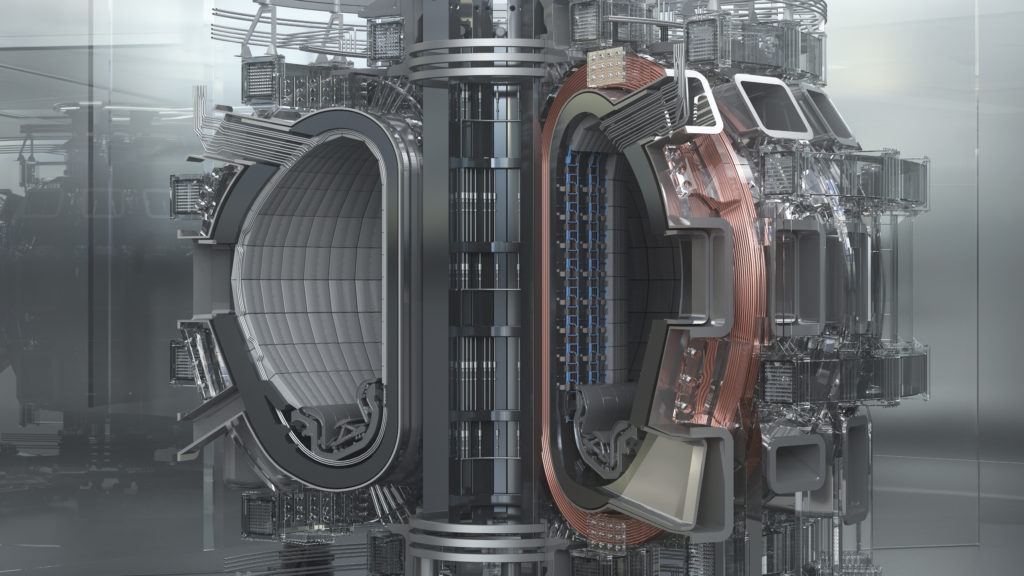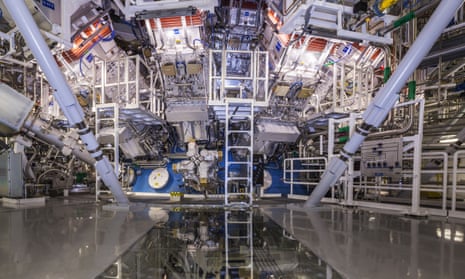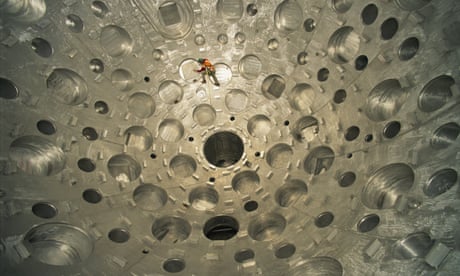SCI FI TECH
US scientists make breakthrough in nuclear fusion energyBloomberg News | December 12, 2022

International Thermonuclear Experimental Reactor. (Stock Image)
Scientists in California have made a key breakthrough in nuclear fusion, a technology with the potential to transform the global energy landscape.

Researchers at the US Department of Energy’s Lawrence Livermore National Laboratory near San Francisco were able produce a fusion reaction that generated more energy than it consumed, according to a person familiar with the research who requested anonymity to discuss results that have not yet been fully disclosed in public.
Fusion is the same process that powers stars and the achievement is a major milestone that shows it may eventually be possible to tame the energy of the sun to create a commercial power plant on Earth. Though that is still many years away, the technology offers the promise of abundant carbon-free electricity.
In the experiment, lasers were used to bombard hydrogen isotopes held in a superheated plasma state in order to fuse them into helium, releasing a neutron and carbon-free energy in the process.
The breakthrough “could be a game changer for the world,” said Representative Ted Lieu, a California Democrat.
Scientists have been experimenting with the technology for decades, but tests typically require enormous amounts of power. Generating a fusion reaction that puts out more energy than it consumes — technically called a net-energy gain — has been elusive.
The reaction produced about 2.5 megajoules of energy compared to the 2.1 megajoules used to power the lasers, according to the Financial Times, which earlier reported the results.
The technology has drawn billions in investments from backers including Jeff Bezos, Bill Gates and Peter Thiel. In recent years, it also started to win support from sovereign wealth funds, national development banks and venture capitalists, a sign that the industry is starting to look more seriously at the concept.
A spokeswoman for the Lawrence Livermore National Laboratory said the analysis was still ongoing and it would share more details Tuesday.
While the results represent a breakthrough, it’s still a long way to creating a viable technology, let alone delivering enough clean energy to help wean the world off fossil fuels and limit climate change.
The technology is different from fission, which is now widely used in commercial nuclear power plants. Fission creates energy by splitting atoms, but also produces radioactive waste. It has been commercially available for decades and still produces only 10% of the world’s power, far less than coal and gas.
Fusion’s potential market share would also be challenged by solar and wind power, both of which are cheaper and have mature supply chains. Their main drawback — intermittent generation — is being addressed by a rapidly growing battery storage industry.
Still, if fusion can be scaled up, it offers the promise of around-the-clock clean power with less risk and hazardous waste than fission. Investment into fusion startups like Commonwealth Fusion Systems and Helion Energy jumped to $2.3 billion in 2021 and will likely total more than $1 billion this year, according to BloombergNEF.
The Energy Department previously said Secretary Jennifer Granholm planned on Tuesday to announce a “major scientific breakthrough” at the national laboratory by researchers with the agency’s National Nuclear Security Administration.
(By Ari Natter and Will Wade, with assistance from Dan Murtaugh)
Breakthrough in nuclear fusion could mean ‘near-limitless energy’
Researchers managed to release more energy than they put in: a positive gain known as ignition

Researchers managed to release more energy than they put in: a positive gain known as ignition

The National Ignition Facility at the Lawrence Livermore National Laboratory system
uses 192 laser beams converging at the centre of this giant sphere. Photograph: Damien Jemison/AP
Nicola Davis Science correspondent
@NicolaKSDavis
Nicola Davis Science correspondent
@NicolaKSDavis
Mon 12 Dec 2022
Researchers have reportedly made a breakthrough in the quest to unlock a “near-limitless, safe, clean” source of energy: they have got more energy out of a nuclear fusion reaction than they put in.
Nuclear fusion involves smashing together light elements such as hydrogen to form heavier elements, releasing a huge burst of energy in the process. The approach, which gives rise to the heat and light of the sun and other stars, has been hailed as having huge potential as a sustainable, low-carbon energy source.
However, since nuclear fusion research began in the 1950s, researchers have been unable to a demonstrate a positive energy gain, a condition known as ignition.
Now, it seems, the Rubicon has been crossed.
According to a report in the Financial Times, which has yet to be confirmed by the National Ignition Facility (NIF) at Lawrence Livermore National Laboratory in California that is behind the work, researchers have managed to release 2.5 MJ of energy after using just 2.1 MJ to heat the fuel with lasers.
Dr Robbie Scott, of the Science and Technology Facilities Council’s (STFC) Central Laser Facility (CLF) Plasma Physics Group, who contributed to this research, described the results as a “momentous achievement”.
“Fusion has the potential to provide a near-limitless, safe, clean, source of carbon-free baseload energy,” he said. “This seminal result from the National Ignition Facility is the first laboratory demonstration of fusion ‘energy-gain’ – where more fusion energy is output than input by the laser beams. The scale of the breakthrough for laser fusion research cannot be overstated.
“The experiment demonstrates unambiguously that the physics of Laser Fusion works,” he added. “In order to transform NIF’s result into power production a lot of work remains, but this is a key step along the path.”

The race to give nuclear fusion a role in the climate emergency
Prof Jeremy Chittenden, professor of plasma physics at Imperial College London, agreed. “If what has been reported is true and more energy has been released than was used to produce the plasma, that is a true breakthrough moment which is tremendously exciting,” he said.
“It proves that the long sought-after goal, the ‘holy grail’ of fusion, can indeed be achieved.”
But experts have stressed that while the results would be an important proof of principle, the technology is a long way from being a mainstay of the energy landscape. To start with, 0.4MJ is about 0.1kWh – about enough energy to boil a kettle.
“To turn fusion into a power source we’ll need to boost the energy gain still further,” said Chittenden. “We’ll also need to find a way to reproduce the same effect much more frequently and much more cheaply before we can realistically turn this into a power plant.”
The planet's most important stories. Get all the week's environment news - the good, the bad and the essential
Privacy Notice: Newsletters may contain info about charities, online ads, and content funded by outside parties. For more information see our Privacy Policy. We use Google reCaptcha to protect our website and the Google Privacy Policy and Terms of Service apply.
Prof Justin Wark, professor of physics at the University of Oxford, added that while, in principle, the Lawrence Livermore National Laboratory could produce such a result about once a day, a fusion power plant would need to do it 10 times a second.
And there is another point: the positive energy gain reported ignores the 500MJ of energy that was put into the lasers themselves.
However, Chittenden stressed the NIF was designed for a scientific demonstration, not as a power plant. “The efficiency of converting electrical energy to laser energy was not a factor in its design,” he said.
“Anyone working in fusion would be quick to point out that there is still a long way to go from demonstrating energy gain to getting to wall-plug efficiency where the energy coming from a fusion reactor exceeds its electrical energy input required to run the reactor,” he added.
“The experiments on NIF demonstrate the scientific process of ignition and how this leads to high fusion energy gain, but to turn this into a power station we need to develop simpler methods to reach these conditions, which will need to be more efficient and above all cheaper in order for inertial fusion to be realised as a fusion power source.”
The latest results, if true, top the last big breakthrough by the facility which came just last year when it was announced that the team had hit 70% of the laser energy put in to the experiment released as nuclear energy.
Researchers have reportedly made a breakthrough in the quest to unlock a “near-limitless, safe, clean” source of energy: they have got more energy out of a nuclear fusion reaction than they put in.
Nuclear fusion involves smashing together light elements such as hydrogen to form heavier elements, releasing a huge burst of energy in the process. The approach, which gives rise to the heat and light of the sun and other stars, has been hailed as having huge potential as a sustainable, low-carbon energy source.
However, since nuclear fusion research began in the 1950s, researchers have been unable to a demonstrate a positive energy gain, a condition known as ignition.
Now, it seems, the Rubicon has been crossed.
According to a report in the Financial Times, which has yet to be confirmed by the National Ignition Facility (NIF) at Lawrence Livermore National Laboratory in California that is behind the work, researchers have managed to release 2.5 MJ of energy after using just 2.1 MJ to heat the fuel with lasers.
Dr Robbie Scott, of the Science and Technology Facilities Council’s (STFC) Central Laser Facility (CLF) Plasma Physics Group, who contributed to this research, described the results as a “momentous achievement”.
“Fusion has the potential to provide a near-limitless, safe, clean, source of carbon-free baseload energy,” he said. “This seminal result from the National Ignition Facility is the first laboratory demonstration of fusion ‘energy-gain’ – where more fusion energy is output than input by the laser beams. The scale of the breakthrough for laser fusion research cannot be overstated.
“The experiment demonstrates unambiguously that the physics of Laser Fusion works,” he added. “In order to transform NIF’s result into power production a lot of work remains, but this is a key step along the path.”

The race to give nuclear fusion a role in the climate emergency
Prof Jeremy Chittenden, professor of plasma physics at Imperial College London, agreed. “If what has been reported is true and more energy has been released than was used to produce the plasma, that is a true breakthrough moment which is tremendously exciting,” he said.
“It proves that the long sought-after goal, the ‘holy grail’ of fusion, can indeed be achieved.”
But experts have stressed that while the results would be an important proof of principle, the technology is a long way from being a mainstay of the energy landscape. To start with, 0.4MJ is about 0.1kWh – about enough energy to boil a kettle.
“To turn fusion into a power source we’ll need to boost the energy gain still further,” said Chittenden. “We’ll also need to find a way to reproduce the same effect much more frequently and much more cheaply before we can realistically turn this into a power plant.”
The planet's most important stories. Get all the week's environment news - the good, the bad and the essential
Privacy Notice: Newsletters may contain info about charities, online ads, and content funded by outside parties. For more information see our Privacy Policy. We use Google reCaptcha to protect our website and the Google Privacy Policy and Terms of Service apply.
Prof Justin Wark, professor of physics at the University of Oxford, added that while, in principle, the Lawrence Livermore National Laboratory could produce such a result about once a day, a fusion power plant would need to do it 10 times a second.
And there is another point: the positive energy gain reported ignores the 500MJ of energy that was put into the lasers themselves.
However, Chittenden stressed the NIF was designed for a scientific demonstration, not as a power plant. “The efficiency of converting electrical energy to laser energy was not a factor in its design,” he said.
“Anyone working in fusion would be quick to point out that there is still a long way to go from demonstrating energy gain to getting to wall-plug efficiency where the energy coming from a fusion reactor exceeds its electrical energy input required to run the reactor,” he added.
“The experiments on NIF demonstrate the scientific process of ignition and how this leads to high fusion energy gain, but to turn this into a power station we need to develop simpler methods to reach these conditions, which will need to be more efficient and above all cheaper in order for inertial fusion to be realised as a fusion power source.”
The latest results, if true, top the last big breakthrough by the facility which came just last year when it was announced that the team had hit 70% of the laser energy put in to the experiment released as nuclear energy.
No comments:
Post a Comment